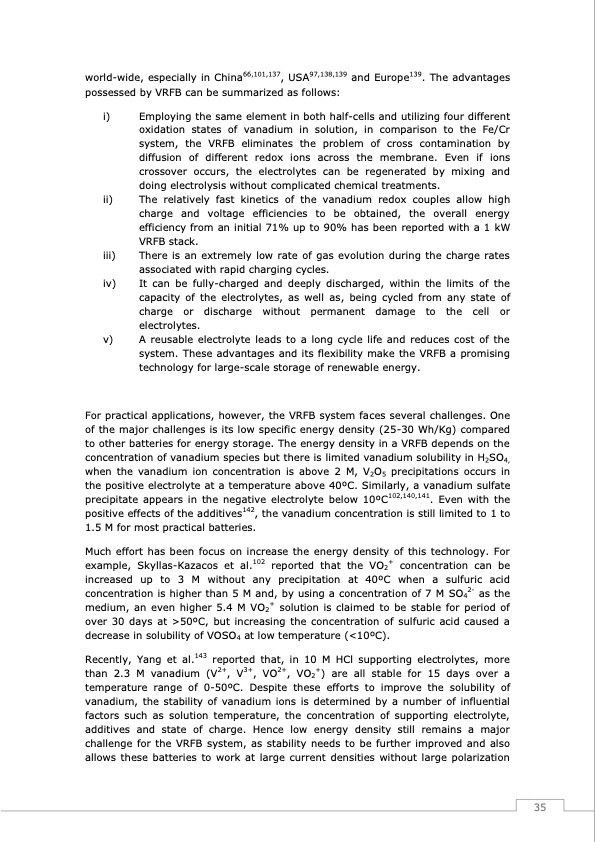
PDF Publication Title:
Text from PDF Page: 036
world-wide, especially in China66,101,137, USA97,138,139 and Europe139. The advantages possessed by VRFB can be summarized as follows: i) Employing the same element in both half-cells and utilizing four different oxidation states of vanadium in solution, in comparison to the Fe/Cr system, the VRFB eliminates the problem of cross contamination by diffusion of different redox ions across the membrane. Even if ions crossover occurs, the electrolytes can be regenerated by mixing and doing electrolysis without complicated chemical treatments. ii) The relatively fast kinetics of the vanadium redox couples allow high charge and voltage efficiencies to be obtained, the overall energy efficiency from an initial 71% up to 90% has been reported with a 1 kW VRFB stack. iii) There is an extremely low rate of gas evolution during the charge rates associated with rapid charging cycles. iv) It can be fully-charged and deeply discharged, within the limits of the capacity of the electrolytes, as well as, being cycled from any state of charge or discharge without permanent damage to the cell or electrolytes. v) A reusable electrolyte leads to a long cycle life and reduces cost of the system. These advantages and its flexibility make the VRFB a promising technology for large-scale storage of renewable energy. For practical applications, however, the VRFB system faces several challenges. One of the major challenges is its low specific energy density (25-30 Wh/Kg) compared to other batteries for energy storage. The energy density in a VRFB depends on the concentration of vanadium species but there is limited vanadium solubility in H2SO4, when the vanadium ion concentration is above 2 M, V2O5 precipitations occurs in the positive electrolyte at a temperature above 40oC. Similarly, a vanadium sulfate precipitate appears in the negative electrolyte below 10oC102,140,141. Even with the positive effects of the additives142, the vanadium concentration is still limited to 1 to 1.5 M for most practical batteries. Much effort has been focus on increase the energy density of this technology. For example, Skyllas-Kazacos et al.102 reported that the VO2+ concentration can be increased up to 3 M without any precipitation at 40oC when a sulfuric acid concentration is higher than 5 M and, by using a concentration of 7 M SO42- as the medium, an even higher 5.4 M VO2+ solution is claimed to be stable for period of over 30 days at >50oC, but increasing the concentration of sulfuric acid caused a decrease in solubility of VOSO4 at low temperature (<10oC). Recently, Yang et al.143 reported that, in 10 M HCl supporting electrolytes, more than 2.3 M vanadium (V2+, V3+, VO2+, VO2+) are all stable for 15 days over a temperature range of 0-50oC. Despite these efforts to improve the solubility of vanadium, the stability of vanadium ions is determined by a number of influential factors such as solution temperature, the concentration of supporting electrolyte, additives and state of charge. Hence low energy density still remains a major challenge for the VRFB system, as stability needs to be further improved and also allows these batteries to work at large current densities without large polarization 35PDF Image | Redox Flow Batteries Vanadium to Earth Quinones

PDF Search Title:
Redox Flow Batteries Vanadium to Earth QuinonesOriginal File Name Searched:
FJVG_TESIS.pdfDIY PDF Search: Google It | Yahoo | Bing
Salgenx Redox Flow Battery Technology: Salt water flow battery technology with low cost and great energy density that can be used for power storage and thermal storage. Let us de-risk your production using our license. Our aqueous flow battery is less cost than Tesla Megapack and available faster. Redox flow battery. No membrane needed like with Vanadium, or Bromine. Salgenx flow battery
| CONTACT TEL: 608-238-6001 Email: greg@salgenx.com | RSS | AMP |